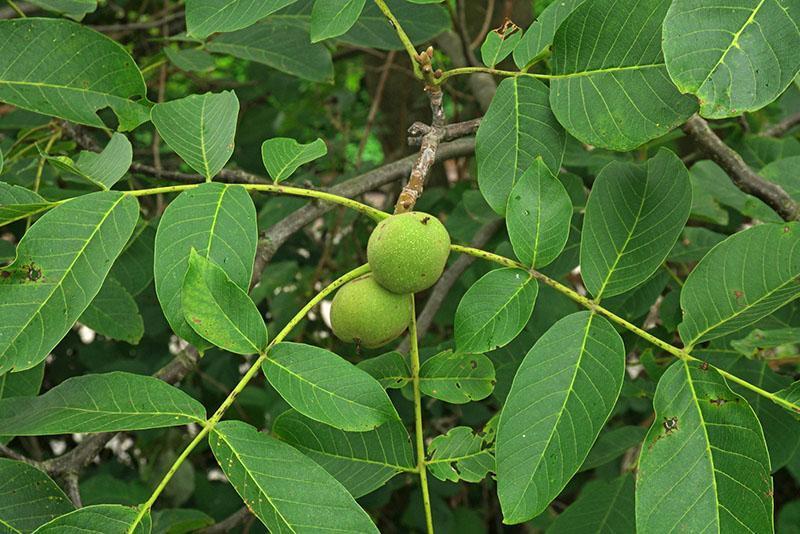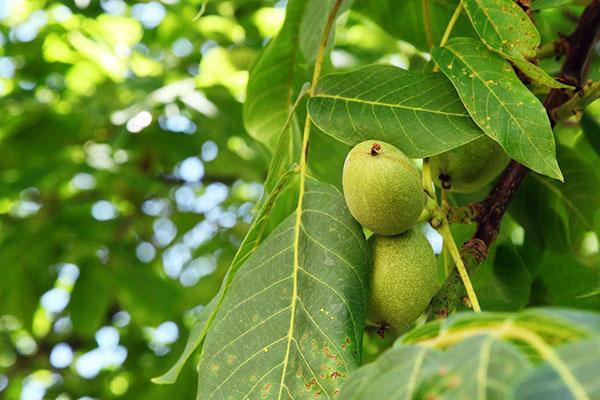Useful properties of walnut leaves and possible contraindications

Walnut - one of those plants that were cultivated in ancient times. However, not everyone knows that not only kernels, but also walnut leaves are valuable to humans, the useful properties and contraindications to the use of which are entirely dependent on the composition of dense lush greenery.
One glance at the walnut tree is enough to remember the unusual cut leaves of this culture, as if consisting of several oval-pointed leathery plates. Opening in May, the foliage of the walnut is actively growing and already in the middle of summer forms a spreading dense crown.
What, apart from creating the shade desired in the summer heat, are the leaves of this fruit tree valuable? How are walnut leaves used in official and traditional medicine?
The composition and medicinal properties of walnut leaves

Green walnut leaves contain in abundance organic acids, essential oils and glycosides, alkaloids and phytoncides, vitamins and trace elements.
There are practically no toxic compounds, allergens or other substances in the composition of greens that can provoke a deterioration in well-being or an exacerbation of a chronic disease. In what areas is the use of walnut leaves most important and effective?
The richness of amino acid composition, as well as the presence of ascorbic acid, carotene, vitamins E, PP and a group of compounds from group B predetermined the use of green raw materials as an excellent general tonic.
 Essential vitamins supply the body with energy, take care of constant cell renewal, support the immune and vascular systems. Due to the abundance of vitamin C, which is especially rich in young foliage, the nervous system receives the necessary nutrition. A person tolerates all kinds of stress better and resists stress more easily.
Essential vitamins supply the body with energy, take care of constant cell renewal, support the immune and vascular systems. Due to the abundance of vitamin C, which is especially rich in young foliage, the nervous system receives the necessary nutrition. A person tolerates all kinds of stress better and resists stress more easily.
In addition, walnut leaves have the ability to:
- heal wounds, including purulent ones;
- resist inflammation, soothe and prevent their appearance;
- dry out the foci of irritation;
- anesthetize;
- stop bleeding and accelerate the formation of a clot.
 Preparations based on natural raw materials are effective against staphylococci, pathogenic fungi, pathogens of intestinal diseases and tuberculosis.
Preparations based on natural raw materials are effective against staphylococci, pathogenic fungi, pathogens of intestinal diseases and tuberculosis.
Since bioactive components stimulate wound healing and stop bleeding, a contraindication for taking walnut leaves, for all their benefits, is thrombophlebitis, as well as individual intolerance.
The pounded fresh foliage, thanks to the abundance of essential oils, helps to ward off annoying insects. And when taken orally, plant alkaloids cope with helminthic invasions.
Application of walnut leaves
 The scope of use of foliage is significant, and there are many ways to use it. The healing properties of walnut leaves are excellently preserved after drying. They turn into decoctions and infusions prepared on their basis, intended for internal and external use.
The scope of use of foliage is significant, and there are many ways to use it. The healing properties of walnut leaves are excellently preserved after drying. They turn into decoctions and infusions prepared on their basis, intended for internal and external use.
In order for the leaves to retain the maximum benefit, they are collected from May to the end of June.For drying, take in shaded, ventilated places and make sure that the raw materials do not get wet and retain a silvery-green shade without dark spots. Juice is made from fresh raw materials, used for all kinds of skin problems, including:
- lichen;
- acne;
- furunculosis;
- eczema;
- diathesis;
- profuse dandruff of the scalp;
- focal baldness;
- long non-healing, complicated wounds.
Pain relieving, soothing properties of the leaves are in demand for sore throat, annoying cough. Gargling with a warm broth relieves discomfort and speeds up the treatment.
 Dried for future use leaves - the basis of decoctions for the treatment of internal bleeding, rickets, general depletion of the body. Research on the beneficial properties of leaves is underway. walnut and contraindications for their use in cancer. It would seem that a simple herbal remedy perfectly helps to strengthen the immune system or restore it after chemotherapy or surgery.
Dried for future use leaves - the basis of decoctions for the treatment of internal bleeding, rickets, general depletion of the body. Research on the beneficial properties of leaves is underway. walnut and contraindications for their use in cancer. It would seem that a simple herbal remedy perfectly helps to strengthen the immune system or restore it after chemotherapy or surgery.
Usually, herbal preparations are rarely and very carefully used for diseases of the digestive system. Walnut leaves are an exception.
They help not only with commonplace disorders, but also relieve pain, inflammation and other unpleasant symptoms characteristic of acute gastritis, peptic ulcer, dysbiosis.
A decoction or tea based on walnut leaves for diabetes helps to normalize sugar levels, support the body and its immune system. The remedy has a similar effect in diseases of the joints, the risk of atherosclerosis. In all these cases, the regenerating ability of plant materials is involved.